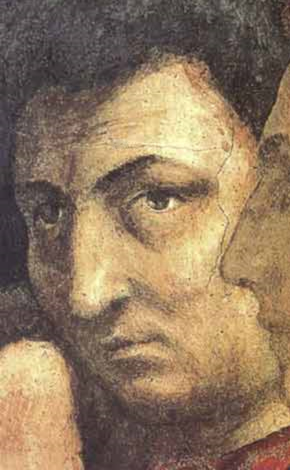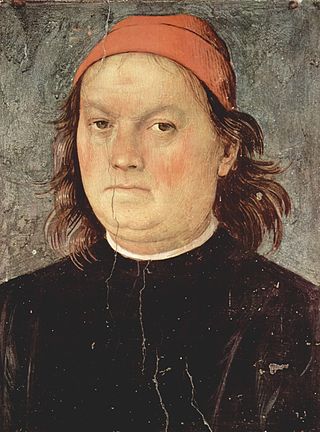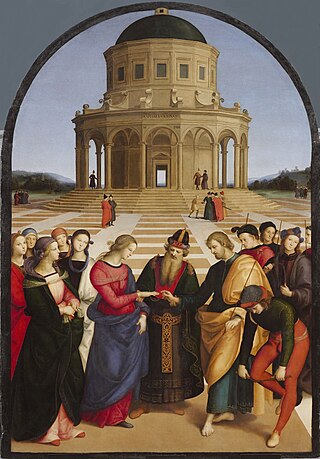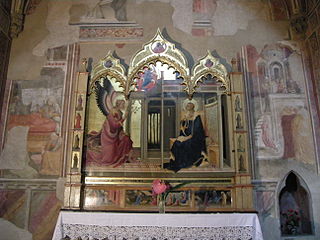
Fra Angelico, OP was a Dominican friar and Italian painter of the Early Renaissance, described by Giorgio Vasari in his Lives of the Artists as having "a rare and perfect talent". He earned his reputation primarily for the series of frescoes he made for his own friary, San Marco, in Florence, then worked in Rome and other cities. All his known work is of religious subjects.

Masaccio, born Tommaso di Ser Giovanni di Simone, was a Florentine artist who is regarded as the first great Italian painter of the Quattrocento period of the Italian Renaissance. According to Vasari, Masaccio was the best painter of his generation because of his skill at imitating nature, recreating lifelike figures and movements as well as a convincing sense of three-dimensionality. He employed nudes and foreshortenings in his figures. This had seldom been done before him.

Piero della Francesca ; né Piero di Benedetto; c. 1415 – 12 October 1492) was an Italian painter of the Early Renaissance. To contemporaries he was also known as a mathematician and geometer. Nowadays Piero della Francesca is chiefly appreciated for his art. His painting is characterized by its serene humanism, its use of geometric forms and perspective. His most famous work is the cycle of frescoes The History of the True Cross in the church of San Francesco in the Tuscan town of Arezzo.

Lorenzo Monaco was an Italian painter and miniaturist of the late Gothic to early Renaissance age. He was born Piero di Giovanni. Little is known about his youth, apart from the fact that he was apprenticed in Florence. He has been considered the last important exponent of the Giotto style, before the Renaissance revolution that came with Fra Angelico and Masaccio.

Antonello da Messina, properly Antonello di Giovanni di Antonio, but also called Antonello degli Antoni and Anglicized as Anthony of Messina, was an Italian painter from Messina, active during the Italian Early Renaissance.

Pietro Perugino, born Pietro Vannucci, was an Italian Renaissance painter of the Umbrian school, who developed some of the qualities that found classic expression in the High Renaissance. Raphael was his most famous pupil.

Florentine painting or the Florentine School refers to artists in, from, or influenced by the naturalistic style developed in Florence in the 14th century, largely through the efforts of Giotto di Bondone, and in the 15th century the leading school of Western painting. Some of the best known painters of the earlier Florentine School are Fra Angelico, Botticelli, Filippo Lippi, the Ghirlandaio family, Masolino, and Masaccio.

Italian Renaissance painting is the painting of the period beginning in the late 13th century and flourishing from the early 15th to late 16th centuries, occurring in the Italian Peninsula, which was at that time divided into many political states, some independent but others controlled by external powers. The painters of Renaissance Italy, although often attached to particular courts and with loyalties to particular towns, nonetheless wandered the length and breadth of Italy, often occupying a diplomatic status and disseminating artistic and philosophical ideas.
The decade of the 1460s in art involved some significant events.

This article about the development of themes in Italian Renaissance painting is an extension to the article Italian Renaissance painting, for which it provides additional pictures with commentary. The works encompassed are from Giotto in the early 14th century to Michelangelo's Last Judgement of the 1530s.

The San Zeno Altarpiece is a polyptych altarpiece by the Italian Renaissance painter Andrea Mantegna created around 1456–1459. It remains in situ in the Basilica di San Zeno, the main church of the Northern Italian city of Verona. Mantegna's style mixes Greco-Roman classical themes along with Christian subjects in this altarpiece. The central panel, along with the three paintings that comprise the predella, were taken in 1797 by the French. While the main, central scene was returned by the French to Verona in 1815, the three predella paintings in Verona today are copies, since the original ones remain in France at the Louvre (Crucifixion) and in the Musée des Beaux-Arts in Tours. The paintings are made with tempera on panel; not oil as mistakenly identified in one source.

The Baptism of Christ is a painting by the Italian Renaissance master Piero della Francesca. Painted in egg tempera on two panels of poplar wood, the dating is controversial – some give it a very early date, perhaps 1439; others much later, around 1460. It is held by the National Gallery, London.

The Polyptych of Perugia is a complex of paintings by the Italian Renaissance master Piero della Francesca, finished around 1470. It is housed in the Galleria Nazionale dell'Umbria, Perugia, Italy.

The Coronation of the Virgin is a painting of the Coronation of the Virgin by the Italian Renaissance master Filippo Lippi, in the Uffizi, Florence.

The Barbadori Altarpiece is a painting by Filippo Lippi, dated to 1438 and housed in the Louvre Museum of Paris.

The Fiesole Altarpiece is a painting by the Italian early Renaissance master Fra Angelico, executed around 1424–1425. It is housed in the Convent of San Domenico, Fiesole, central Italy. The background was repainted by Lorenzo di Credi in 1501.

The Bartolini Salimbeni Annunciation is a tempera on panel painting by the Italian Gothic painter Lorenzo Monaco, completed just before his death (1420–1424). It is housed in the Bartolini Salimbeni Chapel of the church of Santa Trinita, Florence.

San Gregorio Polyptych is a tempera-on-wood polyptych painting by the Italian Renaissance master Antonello da Messina, completed in 1473 and housed in the Regional Museum of Messina, southern Italy.

Andrea di Giusto, rarely also known as Andrea Manzini or Andrea di Giusto Manzini was a Florentine painter of the late Gothic to early Renaissance style in Florence and its surrounding countryside. Andrea was heavily influenced by masters Lorenzo Monaco, Bicci di Lorenzo, Masaccio, and Fra Angelico, and tended to mix and match the motifs and techniques of these artists in his own work. Andrea was an eclectic painter and is considered a minor master of Florentine early Renaissance art. Andrea trained under Bicci di Lorenzo as a Garzone. He painted his most significant works, three altarpieces, in the Florentine contado, or countryside; these altarpieces were created for Sant’Andrea a Ripalta in Figline, Santa Margarita in Cortona, and the Badia degli Olivetani di San Bartolomeo alle Sacce near Prato. Aside from his major altarpieces, Andrea painted several Frescoes over the course of his career. He, along with other minor masters, are also known to have provided several different types of art, including triptychs and frescoes, for Romanesque pievi, or rural churches with baptistries. Moreover, he was well known for several types of smaller craft objects, such as small tabernacles. He is said to have worked between 1420 and 1424 under Bicci di Lorenzo on paintings for Santa Maria Nuova. He is said to have worked with Masaccio in painting the Life of San Giuliano for the Polyptych of Pisa, including the painting of the Madonna and Child, in 1426. He also appears to have collaborated in 1445 with Paolo Uccello in the Capella dell'Assunta in the Prato Cathedral. In 1428, he is listed as a member of the Arte dei Medici e Speziali guild in Florence as "Andrea di Giusto di Giovanni Bugli". His son, Giusto d'Andrea, was also a painter and worked with Neri di Bicci and Benozzo Gozzoli. Andrea died in Florence in 1450.
The Saint Augustine Altarpiece was a mixed-technique 1454-1469 panel painting by Piero della Francesca, now split up and dispersed. It had at least ten panels, not including a probable predella or other panels. Eight panels survive.



















